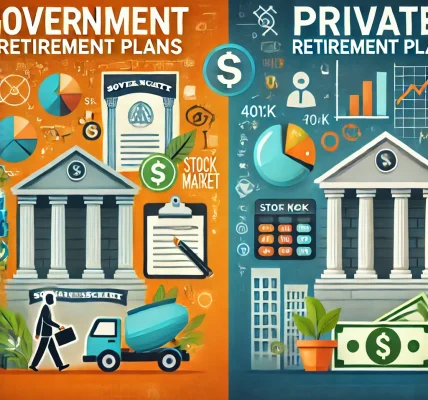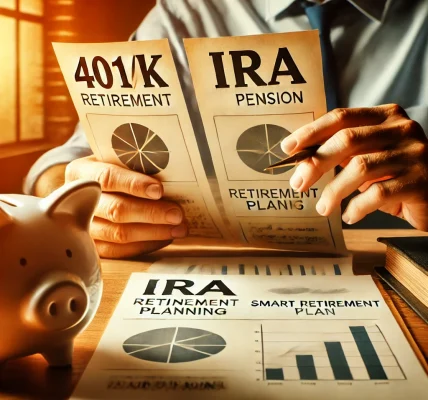Introduction
Inflation is often called the “silent killer” of retirement savings. It gradually reduces the purchasing power of money, making it essential for retirees and future retirees to account for its effects. A well-thought-out retirement plan must include strategies to combat inflation and ensure a comfortable post-retirement life.
In this article, we will discuss how inflation affects retirement savings and explore effective ways to mitigate its impact.
Understanding Inflation and Its Impact on Retirement
What is Inflation?
Inflation refers to the general increase in prices of goods and services over time, leading to a decrease in the purchasing power of money. For example, if the inflation rate is 3% per year, something that costs $1,000 today will cost $1,344 in 10 years and $1,811 in 20 years.
How Inflation Affects Retirement Savings
- Erodes Purchasing Power: Your savings may seem sufficient today, but inflation reduces the value of money over time, making it harder to maintain the same lifestyle.
- Increases Cost of Living: Essential expenses like healthcare, housing, and food typically rise due to inflation, requiring more funds to sustain a comfortable life.
- Reduces Fixed Income Value: Retirees relying on fixed pensions or annuities may struggle as their income remains stagnant while expenses increase.
- Affects Investment Returns: Inflation can diminish real returns on savings and investments, making it crucial to choose investments that outpace inflation.
Ways to Tackle Inflation in Retirement Planning
1. Invest in Inflation-Protected Assets
a. Stocks and Equity Investments
- Historically, the stock market has outperformed inflation over the long term.
- Investing in diversified stocks or equity mutual funds can help grow your wealth beyond the inflation rate.
- Consider dividend-paying stocks for additional income.
b. Treasury Inflation-Protected Securities (TIPS)
- Issued by the U.S. government, TIPS are bonds that adjust for inflation.
- The principal value increases with inflation, ensuring purchasing power protection.
c. Real Estate Investments
- Real estate values generally appreciate over time, making it a hedge against inflation.
- Rental income from properties can provide inflation-adjusted passive income.
d. Commodities and Precious Metals
- Gold, silver, and other commodities often perform well during inflationary periods.
- Adding a small portion of commodities to your portfolio can help diversify risk.
2. Maximize Tax-Advantaged Retirement Accounts
- 401(k), IRA, and Roth IRA: Contributing to these accounts allows your money to grow tax-deferred or tax-free.
- Roth Conversions: A Roth IRA provides tax-free withdrawals in retirement, shielding your funds from future tax increases.
- Health Savings Account (HSA): Inflation also affects healthcare costs. An HSA allows tax-free savings for medical expenses, helping cover increasing healthcare costs.
3. Delay Social Security Benefits
- Social Security benefits increase by approximately 8% per year for each year you delay taking them beyond full retirement age (up to age 70).
- This can provide a higher inflation-adjusted income in later years.
4. Adopt a Flexible Withdrawal Strategy
- The traditional 4% withdrawal rule may not be sufficient if inflation rises significantly.
- Adjust withdrawals based on inflation and investment returns to ensure your savings last longer.
- Consider annuities with cost-of-living adjustments to provide inflation-protected income.
5. Diversify Income Sources
- Relying on multiple income streams ensures stability even if inflation impacts one source.
- Dividend Stocks: Provide passive income that often grows with inflation.
- Real Estate: Rental income can rise over time, keeping up with inflation.
- Side Businesses or Freelancing: Having an additional source of income can help counter inflation’s effects.
6. Plan for Healthcare Costs
- Medicare & Long-Term Care Insurance: Healthcare costs typically rise faster than general inflation. Having proper insurance coverage can prevent unexpected financial strain.
- HSA Contributions: As mentioned earlier, an HSA helps cover medical costs tax-free.
7. Regularly Review and Adjust Your Retirement Plan
- Inflation rates fluctuate over time, making it essential to review your financial plan annually.
- Adjust investment allocations, withdrawal strategies, and expense budgets as needed.
- Work with a financial advisor to optimize your portfolio for inflation protection.
How Different Retirement Plans Handle Inflation
| Retirement Plan | Inflation Protection | Notes |
|---|---|---|
| Pension Plans | Low to Moderate | Fixed pensions lose value over time unless adjusted for inflation. |
| 401(k) & IRA | High | Growth potential with market-based returns, but requires proper investment strategy. |
| Social Security | Moderate | Adjusted for inflation, but may not cover full living costs. |
| Real Estate Investments | High | Rental income and property values tend to rise with inflation. |
| Annuities with COLA | High | Cost-of-Living Adjustment (COLA) annuities provide inflation-protected income. |
Conclusion
Inflation is a critical factor that can erode retirement savings if not planned for properly. By investing in inflation-protected assets, maximizing tax-advantaged accounts, diversifying income sources, and adopting a flexible withdrawal strategy, retirees can maintain their financial security despite rising costs.
Start planning today to ensure that inflation doesn’t derail your retirement goals. Consulting a financial professional can also help tailor a retirement strategy that aligns with your financial needs and inflation expectations.




